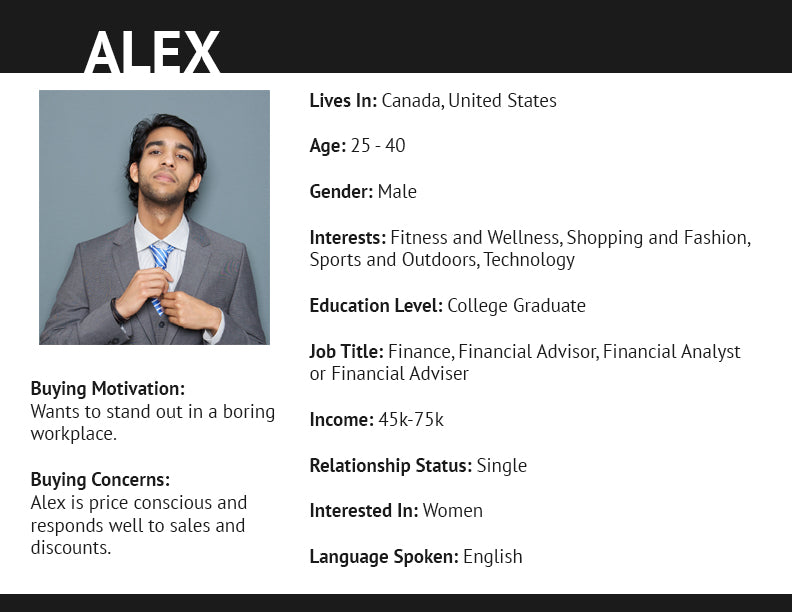You shouldn’t dive into paid advertising or content marketing without knowing exactly who your buyers are. Knowing and understanding who buys, or will buy your products is imperative to help you maximize your advertising return-on-investment and content effectiveness.
To understand core customer groups, it has become a standard for many companies to create buyer (or customer) personas. Buyer personas are fictional, generalized characters that build a picture of your ideal and largest markets. They usually encompass not only demographic information like age, location and income, but also psychographic information like interests, reasons for buying and concerns.
In this post, we'll learn how to build buyer personas for your online business so you can laser target your ads and create more compelling content that will engage your ideal customers.
Why buyer personas are important
What was once an exercise generally only practiced by large companies, is becoming increasingly useful for smaller online retailers. There are a few reasons for this. First, as the online space becomes more and more crowded, it’s becoming increasingly important to have ultra targeted ads and communications. Additionally, the tools to target customers has been democratized to the point that everyone can create campaigns to target customers based on a ever-growing list of demographics and psychographics.
Consider this, Facebook's paid advertising now allows for an incredible amount of advanced targeting based on information like location, age, language spoken, education level and interests. For the first time in history, even with a small budget and as a new online store, you have access to very specific audience targeting.
Free Webinar: Marketing 101
Struggling to grow sales? Learn how to go from first day to first sale in this free training course.
Reserve your seat nowCustomer personas will evolve over time
It's important to remember that your personas will change as you discover more information about your major types of customers and what motivates them. Especially when you're first starting out and creating personas for a brand new business, much of you customer personas will likely be based on personal thoughts, feelings and hunches. However, as your business progresses and you makes sales, you will start learning a lot more about your core customers.
As you learn more, don't forget to go back and continually re-define your buyer personas to ensure you're targeting your potential customers most effectively.
Broadly defining your buyer personas
To begin defining your buyer personas, you'll want to start by being as broad as possible, then drilling down into more specifics. Keep in mind that most businesses will have multiple buyer personas.
As an example, let's use a fictitious online businesses that manufactures and sells bold, colorful socks for men. We will call it Bold Socks.
Because our fictitious sock company manufactures their own socks, it's easy to spot two potential groups of buyers:
- End consumer. These are customers that are purchasing for themselves or as a gift for another person.
- Wholesale accounts. This would include wholesale buyers from other businesses that may want to sell Bold Socks in their own retail and online stores.
Now that we have two very broad buying groups, let's break one of them down further. The first group, End Consumer can definitely be broken down into a few buyer personas so we will use that as our example.
Depending on the type of product you're selling you may dice your personas differently, however, in this particular case, we will divide the end consumer up into two distinct personas:
- Men purchasing for themselves.
- Women purchasing for their boyfriends/husbands as gifts.
Now that we have all of our initial buyer personas broadly defined, it's time to define some key information about them.
Drilling down into buyer persona details
So where do you start when it comes to defining your customer personas? There’s a lot of possible information you could research, use and define, however, a great place to start is by looking at what information you can practically use. Facebook is one of the fastest growing ad networks and it’s also one of the easiest to use. Most importantly, it also has a lot of targeting options that go hand in hand with your customer persona. This makes Facebook Ad’s a great place to start to look for customer persona demographics and psychographics to define.
We've listed some of the major elements to define below for each of your personas:
- Location - Where do people from this persona live?
- Excluding Location - Where do people from this persona not live?
- Age - What is the age range of this persona?
- Gender - What is the gender of people in this persona?
- Interests - What are the interests of people in this persona?
- Education Level - What is the education level of this persona?
- Job Title - What field of work do your customer work in and what types of job titles do they carry?
- Income Level - What is the income range of this buyer persona?
- Relationship Status - What is the relationship status of this buyer persona?
- Language - What languages do people in this persona speak?
- Favorite Websites - Why type of websites do people in this persona frequent?
- Buying Motivation - What is this personas reasons for buying your product?
- Buying Concerns - What is this personas concerns when buying your product?
Keep in mind that you don't need to answer all of these questions about each of your personas and you may opt to answer different questions altogether. However, the purpose should always be to understand your customers more to be able to communicate more effectively, as well as to be able to target your ads more precisely.
How to research your buyer personas
To begin gathering information on each of your buyer personas, you'll want to start with some research and fill in the gaps with assumptions and educated guesses.
If You Have An Already Established Business...
If you have an already established online business, there are tools you likely already have set up that can help you better understand who your current customers are. Some of these tools include Facebook Insights, if you have a Facebook Page set up for your business, as well as Google Analytics Audience Reports, which has some robust information on demographics and some psychographics of your website visitors.

To understand your personas psychographics in depth, your best bet is to talk to your existing customers. The most effective way to do this research is to pick up the phone and call them or by surveying your customers with a tool like Survey Monkey. Since they have purchased from you, they're the type of customer you want more of, so understanding what motivates them to purchase and their biggest concerns can help you more effectively communicate with people similar to them.
If You Don't Have An Already Established Business...
If you don't already have an established online business, a great method to help you fill in the blanks is to look at your biggest competitors. One of the best places to start is by using a service like SimilarWeb or Compete to analyze the traffic of your competitors.
 You can also try visiting your competitors’ blogs and social media pages. Dive into the people who are commenting and interacting with their posts. You can click through to their profiles and learn a lot about them.
You can also try visiting your competitors’ blogs and social media pages. Dive into the people who are commenting and interacting with their posts. You can click through to their profiles and learn a lot about them.
Bringing everything together
Utilizing the tools mentioned in the previous section and some educated guesses we completed our example persona for Bold Socks. Here's what we came up with:
- Locations: Canada, United States
- Age: 25 - 40
- Gender: Male
- Interests: Fitness and Wellness, Shopping and Fashion, Sports and Outdoors or Technology
- Education Level: College Graduate
- Job Title: Finance, Financial Advisor, Financial Analyst or Financial Adviser
- Relationship Status: Single
- Interested In: Women
- Language: English
- Buying Motivation: Wants to stand out in a boring workplace.
- Buying Concerns: Price conscious.
The last thing to do is to make the persona come alive and humanize it. This is typically done by giving the persona a name and photo. You can use an online name generator and use images on LinkedIn or Google Images as long as your personas are for internal use only.
Below, we've completed our persona for Alex, a key persona for our fictitious company, Bold Socks.

How to use buyer personas
With all of your buyer personas defined, you should now have a much better idea of who, how, and where you should be marketing to achieve the greatest level of success. The demographic information of each persona will help you target your ads more effectively, and the psychographic information can help you write more engaging copy for each particular persona.
For example, we know from creating our persona above that advertising a sale or discount to Alex will likely be more effective than trying to advertise quality since we know Alex is price conscious.
Know your customer to improve your marketing
As mentioned previously, your buyer personas will likely change as you learn new information and you may even discover entirely new buyer personas altogether as your business grows.
With defined buyer personas your ad targeting and communication stands a much better chance. From increased engagement on your social media channels to a greater ROI for your online ads, taking the time upfront to define your buyer personas can help your online business succeed by better knowing and understanding your core customers.

